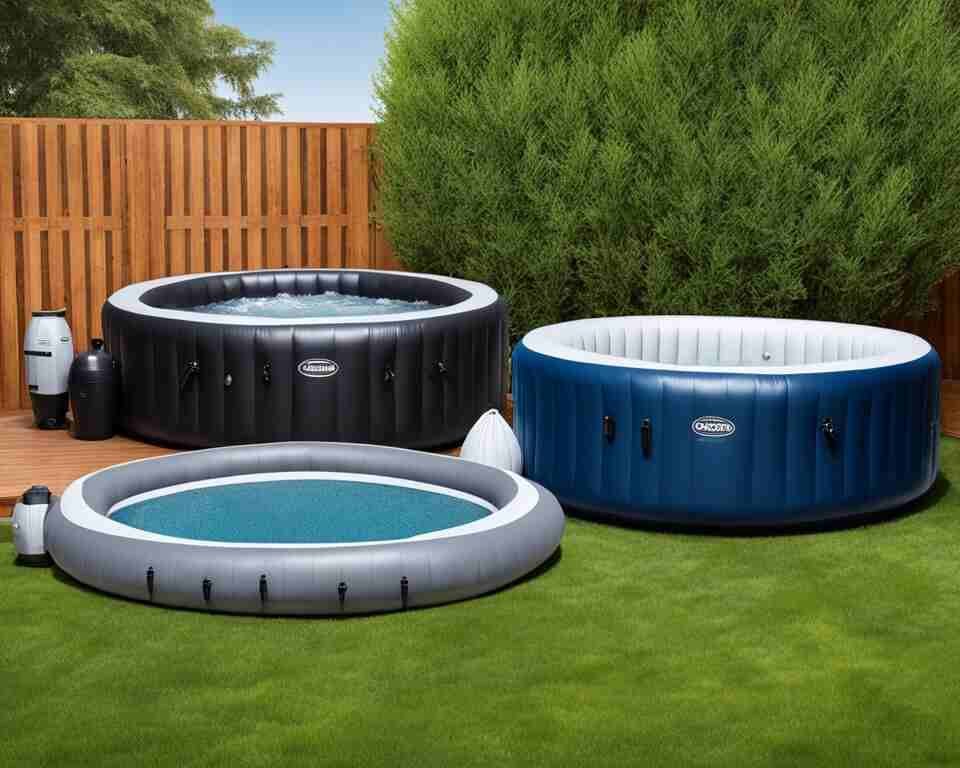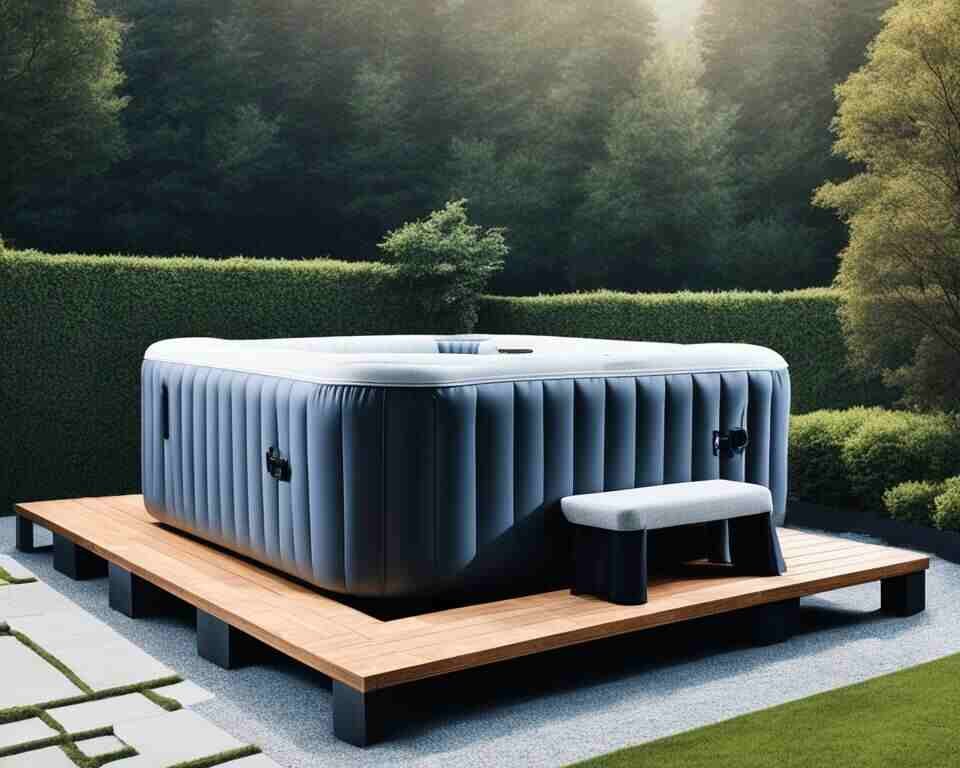When it comes to choosing an inflatable hot tub, one question that often arises is, “How heavy are inflatable hot tubs?” It’s an important consideration, as the weight of the tub can impact its portability, installation, and overall user experience.
In this article, I will provide a comprehensive guide to understanding the weight of inflatable hot tubs, including their average weight, weight capacity, and other factors to consider. So, if you’re curious about the weight of these portable hot tubs, read on to discover all the details.
Key Takeaways:
- Inflatable hot tubs come in various weights depending on their size, capacity, and materials.
- The average weight of inflatable hot tubs ranges from 200 to 500 pounds.
- It’s essential to consider the weight capacity of your hot tub to ensure safe usage.
- Factors such as water capacity, materials, and added accessories can affect the overall weight of the hot tub.
- Proper site selection and structural support are crucial for the safe installation of inflatable hot tubs.

Unveiling the Appeal: Why Choose an Inflatable Hot Tub?
When it comes to relaxation and rejuvenation, an inflatable hot tub offers numerous advantages that make it an enticing option for many. Whether you’re looking to unwind after a long day or create a cozy gathering space for socializing with friends and family, these portable spas provide a convenient and affordable solution. In this section, we will explore the benefits and advantages of choosing an inflatable hot tub over traditional models.
One of the primary reasons why people opt for an inflatable hot tub is its affordability. Compared to permanent fixtures, inflatable models are significantly more cost-effective, allowing you to enjoy the luxury of a hot tub experience without breaking the bank. With their lower price tags, inflatable hot tubs make it accessible for individuals of varying budgets to indulge in the pleasures of hydrotherapy.
Another key advantage of inflatable hot tubs is their portability. Unlike their built-in counterparts, these spas can be easily moved and relocated as needed. This flexibility means that you can set up your hot tub wherever you desire, whether it’s in your backyard, on your patio, or even inside your home. Moreover, their lightweight construction allows for hassle-free transportation, making them the perfect companion for camping trips, vacations, or even moving to a new location.
The ease of installation is yet another benefit of inflatable hot tubs. Unlike traditional hot tubs that often require professional installation and complex plumbing, inflatable models can be set up within minutes without any specialized expertise. With just a few simple steps, you can inflate your spa, fill it with water, and start enjoying the soothing warmth and relaxation it provides.
Furthermore, inflatable hot tubs offer the flexibility to adjust their temperature and settings to suit your preferences. Most models come with user-friendly control panels that allow you to customize the water temperature, jet intensity, and even set timers for automatic heating and filtration cycles. This level of control ensures that you can create the perfect spa experience tailored to your individual needs.
In summary, choosing an inflatable hot tub offers a multitude of benefits. Their affordability, portability, and ease of installation make them an appealing option for those seeking relaxation and hydrotherapy without the high costs and constraints of traditional hot tubs. So, whether you’re looking for a cozy escape or a social gathering spot, an inflatable hot tub provides a versatile and convenient solution for all your relaxation needs.
How Heavy Are Inflatable Hot Tubs?
Inflatable hot tubs offer a portable and affordable solution for enjoying a relaxing soak without the need for a permanent fixture. When considering the weight of an inflatable hot tub, there are several key factors to take into account. In this section, we will explore these weight considerations to help you better understand the overall weight of inflatable hot tubs.
Weight Considerations When Empty
The empty weight of an inflatable hot tub is an important consideration, as it determines the initial weight of the tub before it is filled with water. The empty weight can vary depending on the size and model of the hot tub, ranging from around 50 pounds to 100 pounds or more. It is crucial to know the empty weight of your inflatable hot tub to ensure it can be safely transported and set up in your desired location.
Calculating the Weight With Water
Understanding the weight dynamics of an inflatable hot tub is crucial, especially once it’s filled. On average, these portable tubs can hold anywhere from 150 to 400 gallons of water, contributing to a total weight range of 1,500 to 3,500 pounds when filled, depending on size and capacity.
Larger tubs, with their increased water-holding capabilities, naturally contribute to the higher end of this weight spectrum. This variation underscores the importance of accurately calculating the weight, ensuring your chosen location can provide ample support for both the inflatable hot tub and its water content.
Impact of Occupancy on Overall Weight
The weight capacity of an inflatable hot tub refers to the maximum weight it can safely support when occupied. The weight capacity typically ranges from 2 to 7 people, with higher-capacity hot tubs accommodating more weight.
It is crucial to consider the weight of the occupants along with the weight of the water when assessing the overall weight of the hot tub. Exceeding the weight capacity can compromise the structural integrity of the tub and pose safety risks.
Understanding the weight considerations of inflatable hot tubs, including the empty weight, weight with water, and impact of occupancy, is crucial for safely enjoying your hot tub.
By being aware of these factors, you can make informed decisions regarding the placement, installation, and maintenance of your inflatable hot tub.
Types and Sizes: Inflatable Hot Tub Variations
When it comes to inflatable hot tubs, there is a wide variety of types and sizes available in the market to suit different preferences and spaces. Whether you’re looking for a compact tub for intimate gatherings or a larger one to accommodate more people, there’s an inflatable hot tub for everyone.
Types of Inflatable Hot Tubs:
1. Standard Round: These are the most common type of inflatable hot tubs, featuring a circular shape that promotes socializing and relaxation.
2. Square or Rectangular: If you prefer a more modern or space-efficient design, square or rectangular hot tubs provide a sleek and streamlined look.
3. Oval or Octagonal: Oval or octagonal hot tubs offer a unique shape that adds a touch of elegance to your outdoor space.

1. Compact: These smaller hot tubs are perfect for individuals or couples who have limited outdoor space or prefer a more intimate experience.
2. Standard: Standard-sized inflatable hot tubs comfortably accommodate 4-6 people, making them ideal for small gatherings or family use.
3. Large: For those who love to entertain or have a larger family, large-sized inflatable hot tubs can accommodate 6-8 people, providing ample space for everyone to enjoy.
4. Extra-Large: If you frequently host parties or gatherings, extra-large inflatable hot tubs are designed to accommodate 8 or more people, ensuring everyone can relax and have a great time.
When choosing the right size, consider the available space in your backyard or patio, as well as the number of people who will be using the hot tub regularly.
With the different types and sizes of inflatable hot tubs available, you can easily find the perfect one that suits your needs and preferences. Whether you’re looking for a cozy retreat or a spacious oasis, these versatile hot tubs offer a range of options to enhance your relaxation and enjoyment.
The Importance of Structural Support for Inflatable Hot Tubs
When it comes to enjoying your inflatable hot tub safely and securely, proper structural support is of utmost importance. In this section, I will cover essential aspects of structural support, including site selection, weight limits, precautions, and guidance on moving and setting up your inflatable spa.
Site Selection: Ground-Level vs. Elevated Surfaces
Choosing the right site for your hot tub installation is crucial to ensure long-term stability and prevent any potential damage. Whether you opt for a ground-level or elevated surface depends on various factors, including accessibility, convenience, and personal preference.
If you decide to place your inflatable hot tub on a ground-level surface, make sure it is level, firm, and free from any sharp objects or debris that could puncture the tub. Additionally, consider the weight of the filled hot tub and ensure that the ground can handle the load without sinking or shifting.
Elevated surfaces like decks, patios, and balconies can offer a stable and visually appealing foundation for your hot tub. Yet, it’s crucial to recognize that not all balconies are inherently strong enough.
Consulting with a professional is essential to verify that the structure can adequately support the combined weight of the hot tub, water, and occupants. This precautionary step ensures a safe and enjoyable hot tub experience without compromising the integrity of your elevated space.
Ensuring Safe Installation: Weight Limits and Precautions
Understanding the weight limits of your inflatable hot tub is crucial for both the safety of users and the longevity of the tub itself. Exceeding the recommended weight capacity can lead to structural damage and compromise the overall performance of the tub.
Before installation, carefully review the manufacturer’s guidelines regarding weight limits and follow them meticulously. This includes considering the weight of the tub when empty, plus the additional weight of water and occupants. It is equally important to communicate these weight restrictions to users and ensure they adhere to them at all times.
Moreover, taking necessary precautions during and after installation can significantly contribute to the structural support of your inflatable hot tub. These may include securing the tub with straps or anchors, periodically inspecting the tub for signs of wear or damage, and promptly addressing any leaks or issues that may arise.
Moving and Setting Up Your Inflatable Spa
Moving and setting up an inflatable hot tub requires careful planning and execution to ensure the tub’s structural integrity and user safety. Whether you are relocating your tub within your backyard or transporting it to a different location, following the proper procedures is essential.
Prior to moving the hot tub, ensure it is emptied, deflated, and clean. If needed, refer to the manufacturer’s instructions for deflation and packing. When setting up the tub in a new location, ensure the site meets the necessary requirements for structural support, as discussed earlier.
Take your time to correctly position the tub, inflate it following the manufacturer’s guidelines, and secure it in place if necessary. Carefully monitor the hot tub during the initial filling process to ensure it remains balanced and stable.
By following these guidelines for site selection, weight limits, precautions, and proper installation, you can enjoy your inflatable hot tub with peace of mind, knowing that it is well-supported and safe for use.

Pros and Cons: Is a Lightweight Hot Tub Right for You?
When considering purchasing a hot tub, it’s important to weigh the pros and cons to determine if a lightweight inflatable hot tub is the right choice for you. These portable hot tubs offer several benefits but also come with their own set of disadvantages.
Benefits of Lightweight Hot Tubs
One of the main advantages of inflatable hot tubs is their portability. Unlike traditional hot tubs, which are often heavy and require professional installation, lightweight hot tubs can be easily set up and moved around as needed. This makes them a great option for those who frequently relocate or want the flexibility of changing their hot tub’s location.
Additionally, inflatable hot tubs tend to be more affordable compared to their fixed counterparts. They offer a cost-effective alternative for enjoying the relaxation and therapeutic benefits of a hot tub without breaking the bank.
Furthermore, lightweight hot tubs are relatively easy to maintain. They typically come with user-friendly controls and require minimal cleaning and maintenance, saving both time and effort in the long run.
Disadvantages of Inflatable Hot Tubs
While inflatable hot tubs have their advantages, they also have some drawbacks to consider. One of the main concerns is their durability. Although modern models are made with robust materials, they are still more susceptible to punctures and wear compared to rigid hot tubs.
Inflatable hot tubs also have a smaller water capacity compared to traditional hot tubs. This means they may not comfortably accommodate a large number of occupants, limiting the social aspect of hot tub usage.
Overall, the suitability of a lightweight hot tub depends on your specific needs and preferences. If flexibility, affordability, and ease of installation are important factors for you, an inflatable hot tub can be a great choice. However, if durability and maximum occupancy are a priority, you may need to consider other options.
Pros and Cons of Inflatable Hot Tubs
| Pros | Cons |
|---|---|
| Portability and ease of installation | Less durable compared to rigid hot tubs |
| Affordability | Smaller water capacity |
| Low maintenance |

Inflatable Hot Tub Care and Maintenance
Proper care and maintenance are essential to ensure the longevity and optimal performance of your inflatable hot tub. By following these guidelines, you can keep your spa clean, extend its lifespan, and enjoy a relaxing and hygienic hot tub experience.
Cleaning Inflatable Hot Tubs
To maintain a clean and inviting hot tub environment, regular cleaning is necessary. Here are some steps to follow:
- Drain the hot tub and remove any debris or dirt.
- Use a mild detergent or hot tub cleaner to clean the interior and exterior surfaces of the tub. Avoid using harsh chemicals or abrasive cleaners, as they can damage the material.
- Rinse the tub thoroughly with clean water to remove any remaining residue or cleaning agents.
- Wipe down the tub with a soft cloth or sponge to dry it completely.
- Replace the filter regularly to ensure proper water circulation and filtration.
By following these cleaning steps, you can maintain a clean and hygienic environment for your inflatable hot tub.
Water Treatment for Hot Tubs
Proper water treatment is crucial to maintain the water quality and prevent the growth of bacteria and algae. Here are some key steps to follow:
- Test the water regularly using a hot tub water testing kit to monitor the pH balance, alkalinity, and sanitizer levels.
- Adjust the chemical levels as needed using hot tub chemicals such as chlorine or bromine to ensure a safe and clean environment.
- Shock the water periodically to remove contaminants and maintain water clarity.
- Ensure proper circulation and filtration by running the hot tub’s pump and filter system regularly.
By maintaining proper water treatment, you can enjoy clean and safe water in your inflatable hot tub.
Factors Affecting the Weight of an Inflatable Hot Tub
When considering the weight of an inflatable hot tub, it’s important to understand the various factors that can contribute to its overall weight. In this section, we will explore three key factors that can affect the weight of your hot tub: materials and durability, additional features, and water capacity.
Materials and Durability: Understanding the Build
The materials used in the construction of an inflatable hot tub can significantly impact its weight. High-quality, durable materials such as reinforced PVC or polyester fabric can add strength and stability to the hot tub, but they can also increase its weight. It’s essential to choose a hot tub made from materials that strike a balance between durability and weight.
Additional Features: How Accessories Add Weight
Hot tub accessories, such as seats, cushions, and cup holders, can add extra weight to your inflatable hot tub. While these accessories enhance comfort and convenience, it’s crucial to consider their weight when setting up and moving your hot tub. Be mindful of the maximum weight capacity of your hot tub, taking into account any added accessories.
Water Capacity: The Effect on Total Weight
The amount of water your inflatable hot tub can hold directly affects its overall weight. As the water capacity increases, so does the weight of the hot tub. It’s essential to be aware of the weight limitations specified by the manufacturer to ensure safe and optimal usage. Additionally, keep in mind that the weight of the water will fluctuate based on the number of occupants in the hot tub.
| Hot Tub Model | Water Capacity (Gallons) | Total Weight (lbs) |
|---|---|---|
| Model A | 150 | 900 |
| Model B | 200 | 1,100 |
| Model C | 250 | 1,300 |
Table: Examples of hot tub models with varying water capacities and total weights.
Understanding the factors that can affect the weight of your inflatable hot tub allows you to make informed decisions regarding its setup, maintenance, and usage. By considering materials and durability, additional features, and water capacity, you can ensure a safe and enjoyable hot tub experience.
Conclusion
In conclusion, understanding the weight of inflatable hot tubs is essential when considering their installation and use. Throughout this article, we have explored the various factors that contribute to the overall weight of these portable spas.
From the empty weight of the hot tub itself to the additional weight when filled with water, it is important to consider the weight capacity and structural support required. Additionally, the number of occupants can significantly impact the overall weight, so it is crucial to adhere to the manufacturer’s guidelines.
While inflatable hot tubs offer benefits such as affordability and ease of installation, it is important to acknowledge that their lightweight nature can pose limitations. Considering the pros and cons, it ultimately comes down to personal needs and preferences.
To ensure the longevity and safety of your inflatable hot tub, proper care and maintenance are crucial. Regular cleaning, water treatment, and adherence to maintenance guidelines will help prolong its lifespan and maximize your enjoyment.
Finally, when selecting an inflatable hot tub, carefully assess your available space, weight capacity needs, and desired features. By understanding the weight considerations and making an informed decision, you can enjoy the relaxing benefits of a portable spa without any unexpected surprises.

